
Nuclear engineer / advanced reactor designer (Ph.D. P.E.) who runs https://t.co/ofTjIciUnl.
How to get URL link on X (Twitter) App


 High temperature gas-cooled reactors were first conceived in 1944, and then developed by the Europeans in a multinational collaboration that resulted in the Dragon reactor in the UK. It went critical in 1964. This program developed the beloved coated microsphere fuel (TRISO) and everything. Many other HTGRs followed, such ML-1, Peach Bottom, AVR, Ft. St. Vrain, THTR-300. Today, the HTTR, HTR-10, HTR-PM are all operational outside the US (Japan and China). China has 2 6-packs of them under construction.
High temperature gas-cooled reactors were first conceived in 1944, and then developed by the Europeans in a multinational collaboration that resulted in the Dragon reactor in the UK. It went critical in 1964. This program developed the beloved coated microsphere fuel (TRISO) and everything. Many other HTGRs followed, such ML-1, Peach Bottom, AVR, Ft. St. Vrain, THTR-300. Today, the HTTR, HTR-10, HTR-PM are all operational outside the US (Japan and China). China has 2 6-packs of them under construction.


 The habitat might be a 16 m inflatable ball with 1 meter of radiation shielding. You need shielding from cosmic rays and solar flares anyway, and yes it helps with the reactor radiation too.
The habitat might be a 16 m inflatable ball with 1 meter of radiation shielding. You need shielding from cosmic rays and solar flares anyway, and yes it helps with the reactor radiation too. 




 The 115 kWt reactors used 93% enriched annular UO₂ fuel elements, which transferred heat through a cesium gap, converting about 5% of the heat to electricity. Outside each pin, they had electromagnetically-pumped liquid metal sodium-potassium eutectic coolant.
The 115 kWt reactors used 93% enriched annular UO₂ fuel elements, which transferred heat through a cesium gap, converting about 5% of the heat to electricity. Outside each pin, they had electromagnetically-pumped liquid metal sodium-potassium eutectic coolant. 


 Looking inside that tank, we see numerous shield structures surrounding the core. 2 inches of lead, 'shield solution', more lead, and 2 feet of 2% borated water. Optimization suggested putting 3" of tungsten in there with the lead.
Looking inside that tank, we see numerous shield structures surrounding the core. 2 inches of lead, 'shield solution', more lead, and 2 feet of 2% borated water. Optimization suggested putting 3" of tungsten in there with the lead. 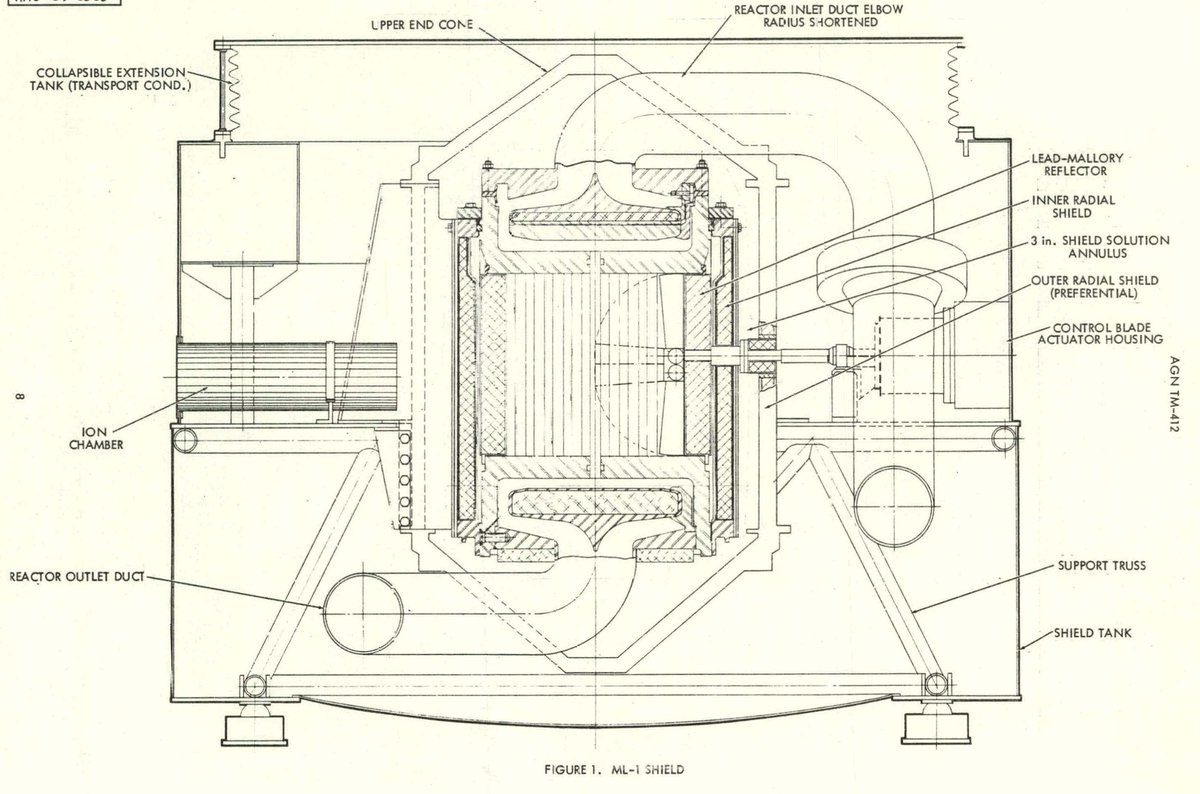

 Eventually, 4 units were built. They were natural uranium metal fueled, CO₂-cooled, graphite-moderated, and clad with a magnesium alloy called 'Magnox'. (2/n)
Eventually, 4 units were built. They were natural uranium metal fueled, CO₂-cooled, graphite-moderated, and clad with a magnesium alloy called 'Magnox'. (2/n) 
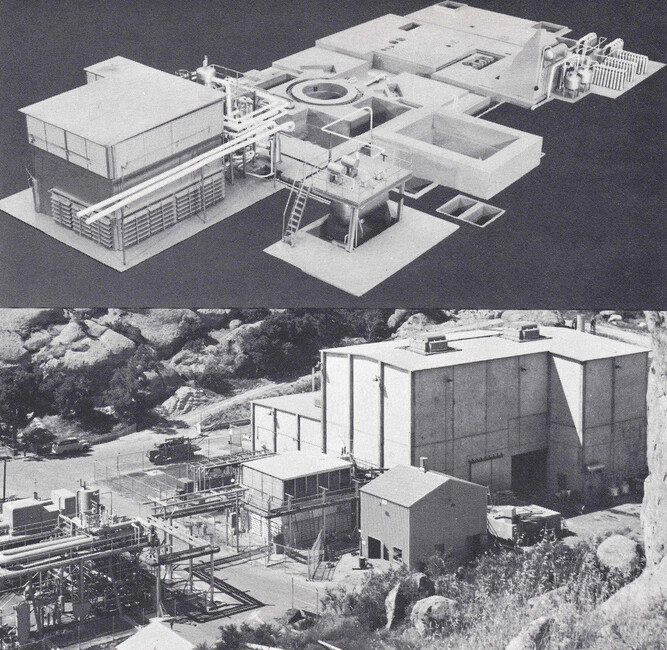
 Then, as today, the best way to verify that your economic suppositions are correct was to build and operate a prototype. Originally the SRE was going to dump all its heat to air, but they ended up hooking it up to generator and putting electricity on the local grid. (2/n)
Then, as today, the best way to verify that your economic suppositions are correct was to build and operate a prototype. Originally the SRE was going to dump all its heat to air, but they ended up hooking it up to generator and putting electricity on the local grid. (2/n) 


 These reactors were nice for research because they were small, inherently safe due to strong negative reactivity feedbacks, "easy" to maintain, and could be operated with a small crew. Here's one being built at the Armour Research Foundation in Chicago (now @IITRI_Chicago) (2/n)
These reactors were nice for research because they were small, inherently safe due to strong negative reactivity feedbacks, "easy" to maintain, and could be operated with a small crew. Here's one being built at the Armour Research Foundation in Chicago (now @IITRI_Chicago) (2/n) 
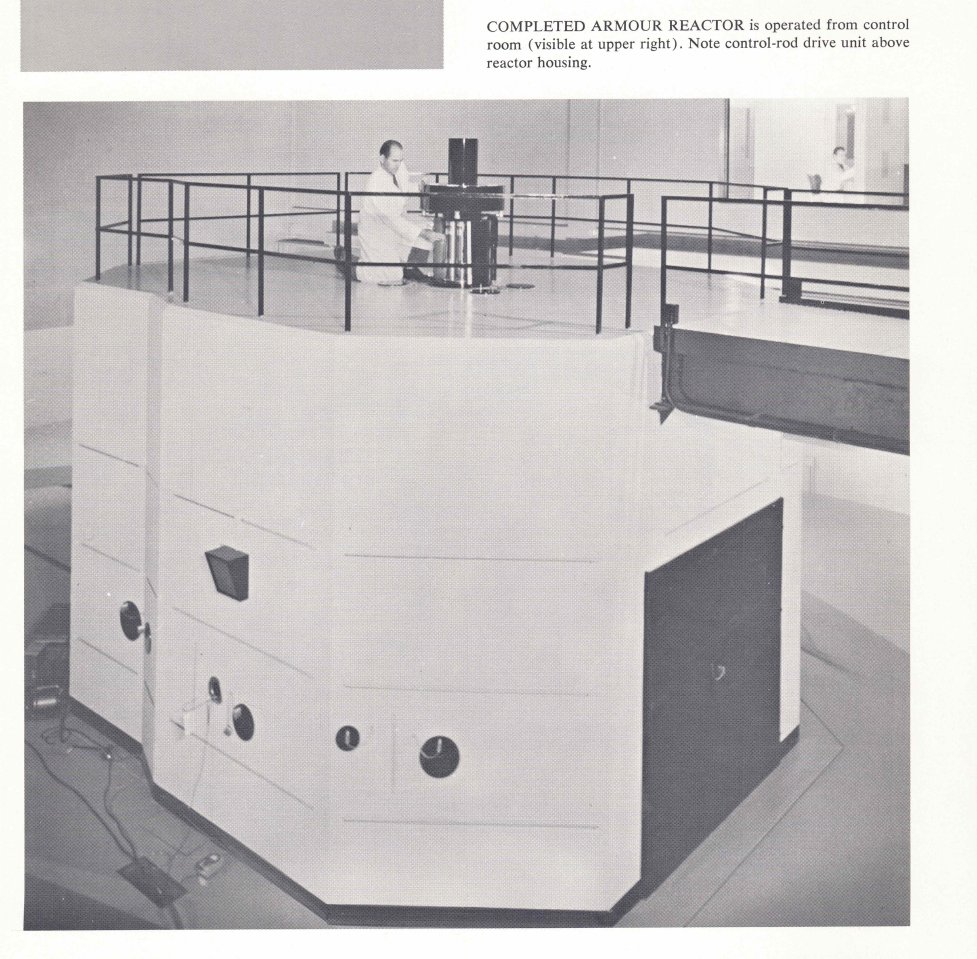

 (2/n) You may recall the nitrogen-cooled/water-moderated ML-1 truck-mounted microreactor that was operated out in Idaho by the US Army. It was built and operated and could kick out 3.3 MW of heat and ~400 kW of gas turbine shaft horsepower. But that wasn't enough power...
(2/n) You may recall the nitrogen-cooled/water-moderated ML-1 truck-mounted microreactor that was operated out in Idaho by the US Army. It was built and operated and could kick out 3.3 MW of heat and ~400 kW of gas turbine shaft horsepower. But that wasn't enough power... 


 And so the Army focused on 'the energy depot' concept, where a nuclear reactor and associated equipment would be used to manufacture chemical fuels from elements universally available in air and water. (kinda like what @isaiah_p_taylorv just announced with Valar Atomics).
And so the Army focused on 'the energy depot' concept, where a nuclear reactor and associated equipment would be used to manufacture chemical fuels from elements universally available in air and water. (kinda like what @isaiah_p_taylorv just announced with Valar Atomics). 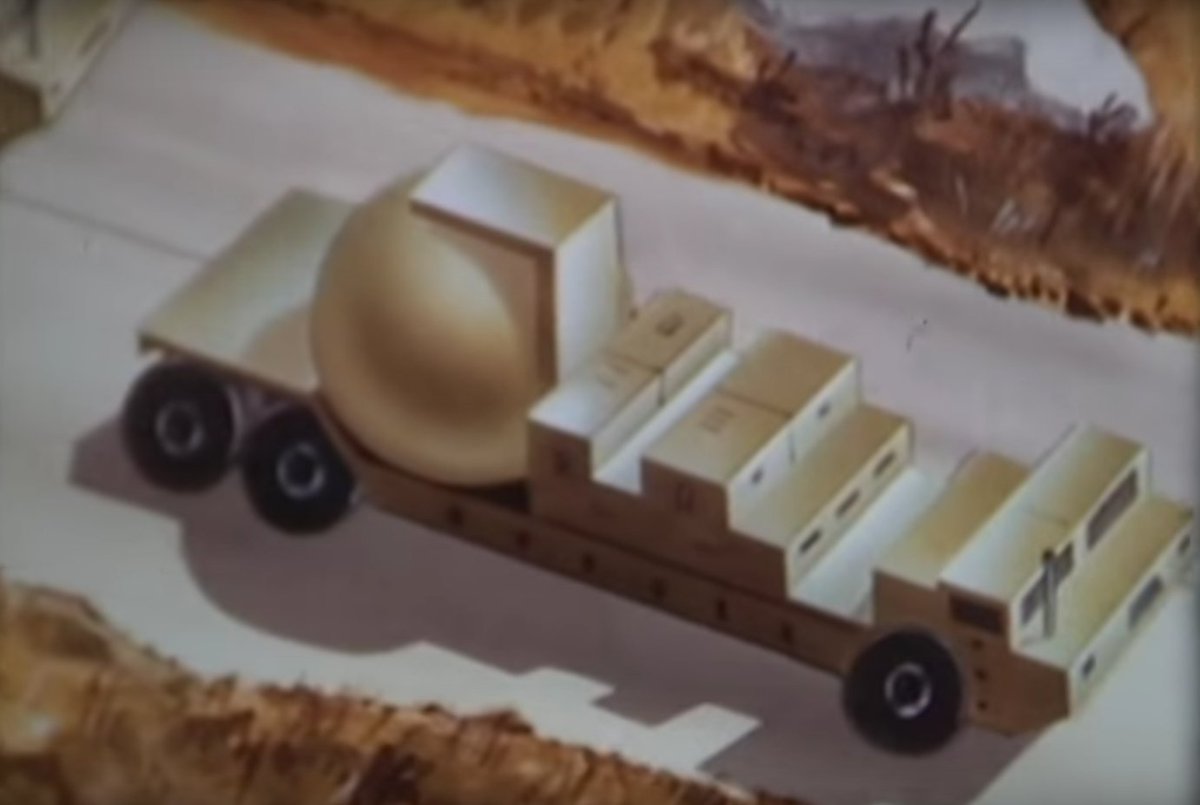




 It contains cost and performance information, summarizing which systems worked well and which ones did not. This is a follow-up to some searching I did after getting this summary film digitized.
It contains cost and performance information, summarizing which systems worked well and which ones did not. This is a follow-up to some searching I did after getting this summary film digitized. https://twitter.com/whatisnuclear/status/1675950732175118336
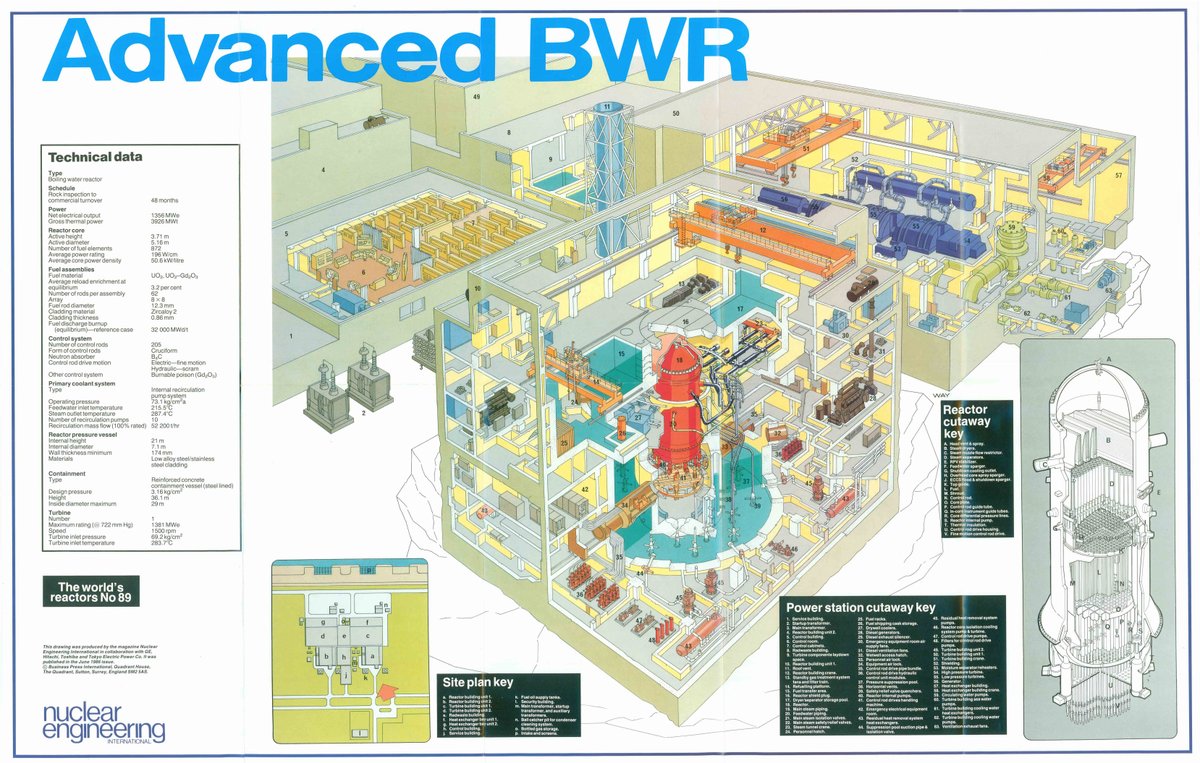
 Having been built before, it's (obviously) a fully-complete design, already licensed and ready to rock in the USA, Japan, and the UK. Here's its design certification from the NRC: nrc.gov/reactors/new-r…
Having been built before, it's (obviously) a fully-complete design, already licensed and ready to rock in the USA, Japan, and the UK. Here's its design certification from the NRC: nrc.gov/reactors/new-r… 

https://twitter.com/JesseJenkins/status/1584325272530485248
 Rather than breeder reactors, we use non-breeder reactors today, which get about 1% of the energy from the mined uranium. Our earlier attempts at deploying more breeder reactors were thrwarted by anti-nuclear activism and minor technology complexities whatisnuclear.com/recycling.html
Rather than breeder reactors, we use non-breeder reactors today, which get about 1% of the energy from the mined uranium. Our earlier attempts at deploying more breeder reactors were thrwarted by anti-nuclear activism and minor technology complexities whatisnuclear.com/recycling.html

 2/ The first obvious example is deep under the sea. After the Navy made nuclear-powered submarines, they immediately went on grand adventures previously unheard of. The Nautilus went to the North Pole under the ice, and the Triton circumnavigated the world without surfacing.
2/ The first obvious example is deep under the sea. After the Navy made nuclear-powered submarines, they immediately went on grand adventures previously unheard of. The Nautilus went to the North Pole under the ice, and the Triton circumnavigated the world without surfacing. 


https://twitter.com/whatisnuclear/status/1449025281948217344
 Basically he was taking the lowest number and the highest number out of a Yale meta-analysis and saying that the 'mean' was the midpoint (around 57). But the real mean is 17.8 and the median is 12.
Basically he was taking the lowest number and the highest number out of a Yale meta-analysis and saying that the 'mean' was the midpoint (around 57). But the real mean is 17.8 and the median is 12.

https://twitter.com/CNN/status/1320032343122464771Natural sunlight produces the entire net quantity of C-14 in all the tanks (63 GBq) every 43 minutes in our atmosphere.